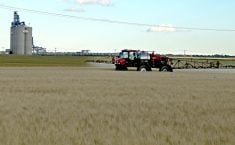It could be a while before changes in international protocol for American hogs entering Canada can be tailored to suit industry players.
“This has to be looked at as an industry issue,” said Brian Jamieson, veterinarian for the Canadian Food Inspection Agency’s animal health and protection
division.
Key groups, including the Canadian Pork Council, Canadian Swine Breeders Association and Canadian Meat Council, met in Montreal late last month to discuss the issue. Representatives from these groups will form a working committee to discuss protocol changes, said Jamieson, adding the Canadian Veterinary Medical Association will probably also have a voice in the process.
Read Also

House ag committee to undertake several studies
The House of Commons standing agriculture committee has set its agenda for the coming months. Members began the fall sitting with a two-hour update on international trade
“There are some pretty polarized views when the group gets together,” said Jamieson.
The CFIA developed guidelines that allowed hogs from some American states to enter Canada as of December 1998. Before then, the Canadian border would stop American imports because many states couldn’t guarantee their hogs were pseudorabies-free.
However, the protocol rules require the U.S. hog manure and straw to be kept separate, which packers think is unworkable. They also feel the protocol presents a trade barrier to the U.S.
Once all players agree on protocol changes, the CFIA will make a recommendation to the federal agriculture minister. It will probably take eight to nine months after that for changes to be implemented.
Jamieson thinks all groups are committed to finding a solution and hopes they can come to a consensus soon. The committee, which could meet before month’s end, doesn’t have a time frame and the CFIA won’t recommend changes without agreement, said Jamieson.
“If there’s no consensus we could still be working on this after the United States eradicates the disease if we’re not careful,” said Jamieson, adding that the Americans aim to eliminate pseudorabies by the end of 2000.
“If we don’t have any agreement it won’t be a success.”
After meeting in Montreal the Canadian Pork Council president, Edouard Asnong, still thinks U.S. hogs could safely enter Canada without protocol changes.
“I still believe if they want to import them they are able to do it.”
Prevention rather than cure
Even if it costs packers money to create a separate manure management system, that investment could be worthwhile, said Asnong.
“Even if the cost is $500,000 to a packing plant it is cheaper to prevent contamination than to spend $10 million when there’s a disease outbreak.”
However, he admits there are scientific questions about the spread of disease through manure that still have to be answered and he’s willing to work through the protocol process. His organization doesn’t want to block U.S. hog imports but wants to make sure the process is safe, he said.
“We know all about trade barriers and we will certainly not play that game. If we do not work with our best will, we can be accused of putting trade barriers in place.”
Jamieson said the CFIA will ensure protocol changes that make trade more workable won’t cause significant safety risks.
“There is no way the CFIA would look at implementing something that would jeopardize our national herd. Period.
“But at the same time there could be some risk. Otherwise people and animals simply wouldn’t be able to move at all.”
















